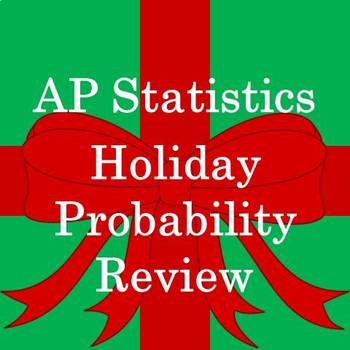AP Statistics Holiday Themed Probability Practice
Samantha Timlin
32 Followers
Grade Levels
10th - 12th, Higher Education
Subjects
Resource Type
Standards
CCSSHSS-CP.A.1
CCSSHSS-CP.A.2
CCSSHSS-CP.A.3
CCSSHSS-CP.A.4
CCSSHSS-CP.A.5
Formats Included
- PDF
Pages
5 pages
Samantha Timlin
32 Followers
Description
This is a great resource to help students review various AP Statistics probability topics.
The questions cover:
- basic probability rules
- the general addition rule
- the general multiplication rule
- Venn diagrams
- tree diagrams
- conditional probability
- binomial and geometric probabilities
- Normal model probabilities
- the use of random variables and probability models
All questions are holiday themed and solutions are included!
Total Pages
5 pages
Answer Key
Included
Teaching Duration
50 minutes
Last updated Jan 15th, 2019
Report this resource to TPT
Reported resources will be reviewed by our team. Report this resource to let us know if this resource violates TPT’s content guidelines.
Standards
to see state-specific standards (only available in the US).
CCSSHSS-CP.A.1
Describe events as subsets of a sample space (the set of outcomes) using characteristics (or categories) of the outcomes, or as unions, intersections, or complements of other events (“or,” “and,” “not”).
CCSSHSS-CP.A.2
Understand that two events 𝘈 and 𝘉 are independent if the probability of 𝘈 and 𝘉 occurring together is the product of their probabilities, and use this characterization to determine if they are independent.
CCSSHSS-CP.A.3
Understand the conditional probability of 𝘈 given 𝘉 as 𝘗(𝘈 and 𝘉)/𝘗(𝘉), and interpret independence of 𝘈 and 𝘉 as saying that the conditional probability of 𝘈 given 𝘉 is the same as the probability of 𝘈, and the conditional probability of 𝘉 given 𝘈 is the same as the probability of 𝘉.
CCSSHSS-CP.A.4
Construct and interpret two-way frequency tables of data when two categories are associated with each object being classified. Use the two-way table as a sample space to decide if events are independent and to approximate conditional probabilities. For example, collect data from a random sample of students in your school on their favorite subject among math, science, and English. Estimate the probability that a randomly selected student from your school will favor science given that the student is in tenth grade. Do the same for other subjects and compare the results.
CCSSHSS-CP.A.5
Recognize and explain the concepts of conditional probability and independence in everyday language and everyday situations. For example, compare the chance of having lung cancer if you are a smoker with the chance of being a smoker if you have lung cancer.



